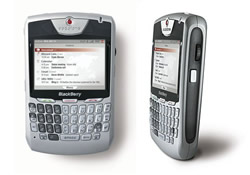Das Mobilfunkunternehmen Base bietet mit dem Base Hotspot E355 seit Mitte Mai 2012 einen neuen Surfstick des chinesischen Herstellers Huawei an. Es handelt sich um ein Kombigerät aus WLAN-Router und UMTS-Surfstick. Nachdem der Stick an den Rechner angeschlossen wurde, kann stundenlang mobil durch das Netz gesurft werden. Die WLAN-Routerfunktion erlaubt den Anschluss von bis zu fünf Geräten und ermöglicht den Aufbau eines privaten Netzwerks. Der integrierte Speicherslot kann microSD-Speicherkarte mit bis zu 32 GB Speicherkapazität aufnehmen.
[Weiterlesen…] Infos zum Plugin Base Hotspot E355 vorgestellt
UMTS
Adding a TCP/IP stack to the BlackBerry 8707v
My first BlackBerry was a 7100v, the first that had the slim form factor and two letters per key – which despite what anyone says, is still more uncomfortable than a full-sized thumb pad. After a couple of years, I have returned to the BlackBerry (but still keep a Nokia N93 handy for pictures & video), getting an 8708v from Vodafone. Main features are a slower non-Intel processor, but CDMA 3G/UMTS technology, which makes surfing and downloading attachments much faster than over GPRS.

After a couple of days of trying to load my favorite software on it, I realized that the 8707v has a very big, very upsetting flaw for anyone who wants to use it beyond email, scheduling and phone duty. It doesn’t have a TCP/IP stack, like other BlackBerries – so connectivity has to be through BES/MDS or BIS, leaving out many applications which need a direct socket connection, for example, the very excellent jmIrc, which kept on saying “could not open tunnel” when trying to get connected. Checking out BlackBerryForums, and Jan-Piet Mens’ blog, the truth started to sink in – RIM had deliberately left out the IP stack, citing unknown problems as the reason. The official statement is here.
Some applications worked, such as Idokorro’s rather good SSH client, and IM+, configured to use a BIS connection. Performance was very poor though, taking a very long time to establish any connection.
Yesterday, I remembered using Opera on the 7100v and being a nice browser than the built-in one, so I set off to download and install it. Not exactly sure how it used to be installed in the days of the 7100v, but this time, when launching Opera, it attempted to run through a series of “tests”, eleven in total, trying to determine how to get connected to the net…and they all failed. A few minutes later on BlackBerryForums, this little gem showed up – explaining the method to configure an APN for the mobile operator in question in order to allow TCP connections – but surely it had to be wrong, the article refered to the 8707v. Well it turned out to be correct, and now, I have a TCP section in Advanced Options, where I can enter an APN, user name and password. I went ahead and tried Vodafone’s APN for Spain, airtelnet.es (Vodafone’s entry into Spain was through the purchase of Airtel, and it seems some things always stay the same!), and it worked! jmIrc also succeeded in connecting to the Freenode IRC server, as all other applications that weren’t working did.
What did installing Opera Mini do? Add a service book? Unlock the dormant stack, or install it? If anyone has an explanation, please do let me know – and to those who were undecided about the 8707v due to the lack of IP connectivity, this seems to be a solution.